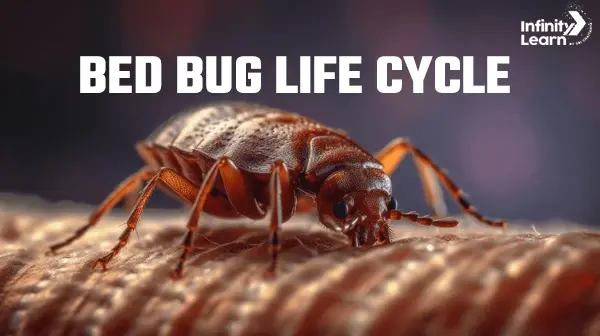Bed bugs are small insects, reddish-brown. They primarily feed on human blood but may also feed on other warm-blooded animals. Resembling the size of an apple seed, these pests often hide in the crevices of mattresses, bed frames, and other soft surfaces where people sleep. While they typically come out to feed at night, they remain hidden during the day, making them difficult to detect.
Although bed bug insect are not known carriers of diseases, their presence can lead to various unpleasant symptoms, such as itching and discomfort. Bedbug insect bites may cause allergic reactions in some individuals, leading to more severe symptoms.

One of the challenges with bed bugs is their ability to hitchhike from one location to another easily. They can travel on furniture, clothing, luggage, and other personal belongings, underscoring the importance of vigilance, especially when staying in hotels or other accommodations. Regular inspection for signs of bed bugs is crucial to preventing infestations.
Bed Bug Life Cycle – Scientific Classification
- Kingdom: Animalia (animals)
- Phylum: Arthropoda (arthropods)
- Class: Insecta (insects)
- Order: Hemiptera (true bugs)
- Family: Cimicidae (bed bugs)
- Genus: Cimex
- Species: Cimex lectularius (common bed bug)
Also Check: Termite Life Cycle
Bed Bug Life Cycle: What are the Different Stages?
The life cycle of a bed bug is interesting and has several important stages that help it grow and survive. Here is a simple breakdown:
Stage 1: Egg Stage
- Appearance: Bed bug eggs are tiny, about 1 mm long, and white in color.
- Duration: It usually takes 6 to 10 days for the eggs to hatch.
- Location: Female bed bugs hide their eggs in places like mattress seams, cracks, and small crevices to protect them.
Stage 2: Nymph Stages
Bed bugs pass through five nymph stages before becoming adults. Each stage requires them to feed on blood to grow to the next stage.
- 1st Stage Nymph: Around 1.5 mm in size.
- 2nd Stage Nymph: Grows to about 2 mm.
- 3rd Stage Nymph: Reaches 2.5 mm in size.
- 4th Stage Nymph: About 3 mm in size.
- 5th Stage Nymph: Grows to approximately 4.5 mm.
Each stage lasts about a week, though it can take longer if food or the environment is not ideal.
Stage 3: Adult Stage
- Appearance: Adult bed bugs are reddish-brown, oval, and flat, measuring between 5 to 7 mm in length.
- Feeding: Adults usually feed on blood at night and can survive for several months without eating.
- Reproduction: A single female bed bug can lay around 200 to 250 eggs during her lifetime.
- Lifespan: Adult bed bugs live for 6 to 12 months, depending on the environment.
Bed Bug Life Cycle Timeline
Bed bugs go through several stages in their life cycle: they start as eggs, then grow through five young stages called nymphs, and finally become adults. Each stage needs a blood meal to grow and move on to the next one. Depending on conditions like temperature and food availability, the whole life cycle can take a few weeks to several months.
Also Check: Snail Life Cycle
Bed Bug Life Cycle in Days
In days, the life cycle of a bed bug can vary. Eggs usually hatch in 6 to 10 days. Each nymph stage lasts about a week if the bed bugs can feed on blood. So, from egg to adult, it generally takes about 35 to 48 days in ideal conditions. If food is hard to find or temperatures are low, it may take longer.
Bed Bug Life Cycle in Weeks
When looking at the life cycle in weeks, it usually takes about 5 to 7 weeks from egg to adult. This includes the time for eggs to hatch and for nymphs to grow through their five stages. Warmer temperatures and easy access to food can speed up this process, while cooler temperatures and food shortages can slow it down.

Bed Bug Life Cycle without Food
Bed bugs can go a long time without eating because they can slow down their bodies and enter a resting state. The following is a Bed Bug life cycle without food and how they survive without food:
- Eggs: Bed bug eggs hatch in about 6 to 10 days. They don’t need food at this stage, so they aren’t affected by a lack of it.
- Nymphs: After hatching, bed bugs grow through five stages called nymphs. They need at least one blood meal to grow to the next stage. Nymphs can live for several weeks to a few months without food, depending on the temperature and humidity.
- Adults: Adult bed bugs are tougher and can survive without food for 4 to 5 months at room temperature. In cooler conditions, they can last over a year without a meal.
Their ability to live for a long time without eating makes them hard to get rid of. If you have a bed bug problem, it’s a good idea to seek help from pest control professionals.
Also Check: Sea Turtle Life Cycle
Bed Bug Life Cycle Size
The life cycle of a bed bug includes several stages, each with different sizes:
- Eggs: Very small, about 1 mm, and pearl-white.
- 1st Stage Nymph: About 1.5 mm long.
- 2nd Stage Nymph: Around 2 mm in length.
- 3rd Stage Nymph: About 2.5 mm long.
- 4th Stage Nymph: Roughly 3 mm in size.
- 5th Stage Nymph: Approximately 4.5 mm long.
- Adult Bed Bugs: Typically 5-7 mm, similar to the size of an apple seed. They can look flat and brown or round and reddish-brown after feeding.
Bed bugs go through these stages as they grow, and each nymph stage needs a blood meal to move to the next stage.
How Long do Bed Bugs Live?
Bed bugs usually live for about 4 to 6 months. However, in the best conditions, they can survive for up to a year. They are very tough and can go without a blood meal for several months, depending on their surroundings.
| Life Cycle’s | |
| Butterfly Life Cycle | Dragonfly Life Cycle |
| Plasmodium Life Cycle | Fish Life Cycle |
| Schistosomiasis Life Cycle | |
How to Prevent Bedbug Insects?
Certain proactive steps can be taken to minimize the risk of a bed bug infestation, although complete prevention can be challenging. These measures include:
- Regularly vacuum and steam-clean mattresses and bedding. This helps eliminate any bed bugs or eggs that may be present.
- Using bed bug-proof encasements on mattresses and box springs. These encasements are designed to prevent bed bugs from entering or escaping from bedding.
- Maintaining a clutter-free living space. Reducing clutter minimizes the hiding places for bed bugs, making it easier to spot and address any potential infestations.
- Carefully inspect any second-hand furniture before bringing it into your home. Second-hand items can be a common source of bed bug infestations.
If you suspect a bedbug insect in your home, it’s advisable to contact a professional pest control service. Early detection and prompt treatment are crucial for effectively managing and eliminating bed bugs. Pest control professionals have the expertise and tools to assess the situation and implement an effective treatment plan accurately.
Interesting Facts – Bed Bug Life Cycle
- Scientifically, bed bugs are referred to as Cimex lectularius, belonging to the Cimicidae family within the Heteroptera order.
- The bed bug life cycle comprises seven distinct stages.
- These stages include the egg, followed by five nymph stages (1st to 5th), and the adult stage.
- During each nymph stage, the size of the bed bug changes progressively.
- Initially, in the 1st nymph stage, a bed bug measures about 1.5 mm, growing to 4.5 mm by the 5th nymph stage, with incremental growth at each stage.
- Bedbugs reach reproductive maturity once they become adults.
- In the adult stage, bed bugs do not require daily feeding and can survive up to 18 months.
FAQs on Bed Bug Life Cycle
What kills bed bugs permanently?
Heat treatment, exposing them to temperatures above 120°F (49°C) for several hours, is very effective. Chemical insecticides designed for bed bugs and mattress encasements can also help prevent infestations.
How long is the life cycle of a bed bug?
Bed Bug Life Cycle includes three main stages: egg, nymph, and adult. Under ideal conditions, it takes about one month for a bed bug to grow from an egg to an adult.
How long does it take to get bed bugs away?
Eliminating bed bugs can take several weeks to a few months, depending on the infestation severity and treatment methods used. Multiple treatments may be necessary for complete eradication.
What is the lifespan of a bed bug without blood?
Bed bugs can survive without a blood meal for about 20 to 400 days, depending on temperature and humidity. They can enter a dormant state to conserve energy when food is limited.
Can bed bugs transfer diseases to humans?
Bed bugs are not known to transmit diseases to humans. Their bites can cause itchy welts and may lead to secondary infections from scratching.






